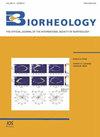血栓性炎症中白细胞、血小板和血管壁之间相互作用的流变学原理
IF 0.8
4区 医学
Q4 BIOPHYSICS
引用次数: 0
摘要
白细胞和血小板必须附着在血管壁上,才能在炎症和止血过程中发挥保护功能。招募主要取决于流变学变量(血管壁剪切率和应力、红细胞聚集和血细胞比容),这些变量会影响向血管壁的输送以及在血管壁上的速度和力量。只有在血管壁剪切速率达到约 300 s-1 时,白细胞招募才会有效,而且通常仅限于炎症中低剪切力的毛细血管后静脉。血小板较小,在靠近管壁处受到的速度和剪切力较低,可以在动脉中以更高的剪切率粘附止血。此外,我们还发现血细胞比容或红细胞聚集的变化对中性粒细胞或血小板附着的影响截然不同,这也有助于它们在静脉或动脉中的单独募集。然而,越来越明显的是,炎症反应和血栓反应可能同时发生,血小板会促进中性粒细胞和单核细胞的粘附和活化。事实上,自我们证明血小板可使中性粒细胞悬浮聚集,并在附着于表面时支持选择素介导的所有白细胞滚动以来,已有 30 年的时间了。凝血酶激活的血小板可进一步诱导中性粒细胞活化和固定。在某些情况下,血小板可与完整的内皮单层结合并捕获中性粒细胞或单核细胞。随后,我们发现活化的血小板释放的细胞外囊泡(PEV)在沉积于内皮细胞表面或与内皮细胞结合时也具有类似的功能。在小鼠模型中,血小板或 PEV 可在发炎的血管中充当单核细胞的桥梁。因此,白细胞和血小板在流变学上适应各自的功能,而利用血小板或 PEV 的新型血栓-炎症途径可能是致病性白细胞招募的基础。本文章由计算机程序翻译,如有差异,请以英文原文为准。
The rheology of interactions between leukocytes, platelets and the vessel wall in thrombo-inflammation
Leukocytes and platelets must adhere to the wall of blood vessels to carry out their protective functions in inflammation and haemostasis. Recruitment is critically dependent on rheological variables (wall shear rate and stress, red cell aggregation and haematocrit) which affect delivery to the vessel wall as well as velocities and forces experienced there. Leukocyte recruitment is efficient only up to wall shear rates of about 300 s−1 and usually restricted to low-shear post-capillary venules in inflammation. Being smaller, platelets experience lower velocities and shear forces adjacent to the wall and can adhere at much higher shear rates for haemostasis in arteries. In addition, we found quite different effects of variations in haematocrit or red cell aggregation on attachment of neutrophils or platelets, which also assist their separate recruitment in venules or arteries. However, it has become increasingly evident that inflammatory and thrombotic responses may occur together, with platelets promoting the adhesion and activation of neutrophils and monocytes. Indeed, it is 30 years since we demonstrated that platelets could cause neutrophils to aggregate in suspension and, when attached to a surface, could support selectin-mediated rolling of all leukocytes. Thrombin-activated platelets could further induce neutrophil activation and immobilisation. In some conditions, platelets could bind to intact endothelial monolayers and capture neutrophils or monocytes. Subsequently, we found that extracellular vesicles released by activated platelets (PEV) fulfilled similar functions when deposited on surfaces or bound to endothelial cells. In murine models, platelets or PEV could act as bridges for monocytes in inflamed vessels. Thus, leukocytes and platelets are rheologically adapted for their separate functions, while novel thrombo-inflammatory pathways using platelets or PEV may underlie pathogenic leukocyte recruitment.
求助全文
通过发布文献求助,成功后即可免费获取论文全文。
去求助
来源期刊

Biorheology
医学-工程:生物医学
CiteScore
2.00
自引率
0.00%
发文量
5
审稿时长
>12 weeks
期刊介绍:
Biorheology is an international interdisciplinary journal that publishes research on the deformation and flow properties of biological systems or materials. It is the aim of the editors and publishers of Biorheology to bring together contributions from those working in various fields of biorheological research from all over the world. A diverse editorial board with broad international representation provides guidance and expertise in wide-ranging applications of rheological methods to biological systems and materials.
The scope of papers solicited by Biorheology extends to systems at different levels of organization that have never been studied before, or, if studied previously, have either never been analyzed in terms of their rheological properties or have not been studied from the point of view of the rheological matching between their structural and functional properties. This biorheological approach applies in particular to molecular studies where changes of physical properties and conformation are investigated without reference to how the process actually takes place, how the forces generated are matched to the properties of the structures and environment concerned, proper time scales, or what structures or strength of structures are required.
 求助内容:
求助内容: 应助结果提醒方式:
应助结果提醒方式:


